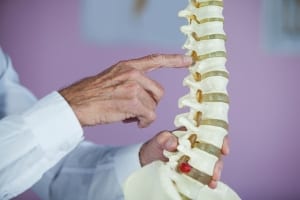The spine has 33 vertebrae, referred to as using letters and numbers depending on their location. The vertebrae of the cervical spine

are referred to as C1 to C7, and constitute, as their name indicates, the upper part of the spine.
This part of the spine is considered more stable and less susceptible to the injuries that are characteristic of the lumbar spine (e.g. back pain caused by a load of weight on the back, disc herniation, and disc protrusion). This does not mean that the cervical spine cannot be injured: just as is the case for any part of the body, there also various medical problems requiring treatment that may be discovered. In particularly severe cases, an operation may even be needed in this region, in order to strengthen the cervical vertebrae and the entire region. Such an operation is called cervical spine fixation surgery.
Reasons for selecting the surgical option include:
- Trauma: Injury to spinal vertebrae from an external cause (e.g. injury in a motor vehicle accident)
- Herniated disc: When the herniation is severe and is even liable to exert pressure on important nerves in the area
- Cancerous tumor: A tumor could “eat into” bone and impair its strength
- Degeneration of the vertebra: Degeneration is usually caused by older age and causes weakening of the bone
- Severe scoliosis: Scoliosis could also affect the stability of the region
General information about the procedure
The need for cervical spine fixation surgery arises when a problem is discovered that causes instability in this area or possible neurological damage. As is the case for most spinal damage or injury, here also the clinical staff will choose to perform a range of conservative treatments, which are usually effective in improving the condition, such as physiotherapy, taking pain killers, lots of rest, which will reduce the load on the spine etc. But when conservative treatments do not help, or when there is danger of irreversible damage (e.g. neurological damage to central nerves in the area), the best option will be an operation.
The operation is performed with the objective of fixating vertebrae one to the other in order to achieve more stability of the spine. The fixation is performed using strong metal plates, which with time with be “strengthened” by the body itself, in a process that will strengthen and thicken the layer of bone in the area of the fixation. Significant strengthening of the vertebrae of the area will thus be generated.
Preparation for cervical spine fixation
The operation is performed under general anesthesia. You will, therefore, be asked to fast for several hours beforehand. Apart from this, no significant preparation is required.
The course of the procedure
Cervical spine fixation surgery is performed under general anesthesia, by two approaches – anterior approach or posterior approach. In the anterior approach, the operation is performed via the neck: the medical team accesses the cervical spinal vertebrae from the front, close to the esophagus and trachea because the anatomy of this area makes the operation simpler in this way.
In the posterior approach, an incision will be made in the patient’s nape, enabling direct access to the vertebrae – but from behind. This option will be selected mainly when the problem is considered to be wide-scale, affecting several vertebrae together, due to the larger room for movement provided by this approach.
Cervical spine fixation surgery can be performed by a minimally invasive approach (via tiny incisions in the neck or nape), but today also, it is performed by an open approach, via a large surgical incision. It is considered to be an operation that is not brief, taking between two and three hours.
The treatment of the vertebrae themselves depends on the type of problem: there are instances in which a bone or cartilage graft is also needed in order to contribute to the stability of the spine in this area. In these instances, the operation will, of course, take longer. The “added” bone or cartilage can be taken from another area of your body (bones of the pelvis, for example) or from an external donation.
The fixation itself will typically be made between two vertebrae only, in order to enable stability in the region on the one hand, while impairing the body’s freedom of movement as little as possible. The physician will fixate one vertebra to the other using strong metal plates, which will provide the spine with the initial stability so sorely needed. With time, the body will “envelope” the metallic bone fixation, as part of a natural process, making the fixation even stronger, ultimately achieving the required stability.
In the initial days after the operation, sometimes for several weeks, you will be required to avoid various activities such as lifting heavyweights. The clinical staff will instruct you exactly how to conduct yourself during this period.
Side Effects
Understandably, one of the central implications of cervical spine fixation surgery is restriction in movement, but usually, especially when the fixation is in the region of the neck, movement will be restricted to a very small extent (and furthermore, the medical team will plan the operation in advance in such a way as to minimize the restriction as much as possible).
Patients undergoing such an operation by anterior approach might also suffer swallowing problems, a hoarse voice, and pain in the region of the neck, mainly due to swelling of the esophagus and trachea, which were moved during the operation. These effects should pass within a few days. In both approaches, weakness of the shoulder muscles could develop, but this can be treated with physiotherapy.
For advice and further information, contact us at telephone: +972-9-959-4888, or leave your details and we will get back to you promptly.
 Patients Log In
Patients Log In 










